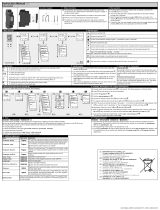
SafePLC2 manual
Programming manual SafePLC2 V2.5.docx
Page
3 of 437
6.3 Inserting Output elements .......................................................................................73
6.4 The Logic Modules .................................................................................................74
6.5 Wiring .....................................................................................................................74
6.5.1
Signal Trace ...................................................................................................................... 76
6.6 Using Groups ..........................................................................................................78
6.7 Program Creation ...................................................................................................78
6.8 Backup copy on MC card ........................................................................................80
6.9 Transferring the Program on the Device .................................................................81
6.10 Offline simulation ................................................................................................83
6.11 Diagnostics ........................................................................................................85
6.11.1
Procedure for function block diagram diagnose .......................................................... 87
6.11.2
Hiding Tabs in Diagnostics .......................................................................................... 90
6.11.3
Log Book ...................................................................................................................... 91
6.12 The Scope monitoring ........................................................................................92
6.12.1
Procedure when measuring with the scope ................................................................. 96
6.12.2
Preparing the measurement ........................................................................................ 96
6.12.3
"Start" measurement .................................................................................................... 96
6.12.4
"Stopping" a measurement and viewing data .............................................................. 96
6.12.5
Measuring schemes ..................................................................................................... 97
7 Configuration Report ................................................................................................ 102
8 Document Properties ................................................................................................ 105
9 Device interface ......................................................................................................... 106
10 Export dialog ....................................................................................................... 110
11 Networks ............................................................................................................. 120
11.1 Safe Master-to-Master communication (SMMC) ............................................... 120
11.1.1
Description ................................................................................................................. 120
This is a network for safety-related master-to-master communication. It must comprise at least
two masters and can have a maximum of four. A typical application would be a higher-level
emergency stop. .......................................................................................................................... 120
11.1.2
Creating...................................................................................................................... 121
11.1.3
Deactivating ............................................................................................................... 121
11.1.4
Configuration .............................................................................................................. 122
11.1.5
Using SMMC communication .................................................................................... 124
11.2 SD-Bus............................................................................................................. 125
11.2.1
Description ................................................................................................................. 125
11.2.2
Creating...................................................................................................................... 126
11.2.3
Configuration .............................................................................................................. 130
11.2.4
Using SD-Bus ............................................................................................................ 130
11.3 Fieldbus ........................................................................................................... 131
11.3.1
Description ................................................................................................................. 131
11.3.2
Creating...................................................................................................................... 132
11.3.3
Configuration .............................................................................................................. 135
11.3.4
Using Standard and Safety fieldbus network ............................................................. 152
11.4 Decentral .......................................................................................................... 164
11.4.1
Creating...................................................................................................................... 164
12 Library Content ................................................................................................... 165
12.1 Device modules ................................................................................................ 167
12.1.1
Master devices ........................................................................................................... 167
12.1.2
Slave devices ............................................................................................................. 167
12.1.3
SD-Bus Group ............................................................................................................ 168




















